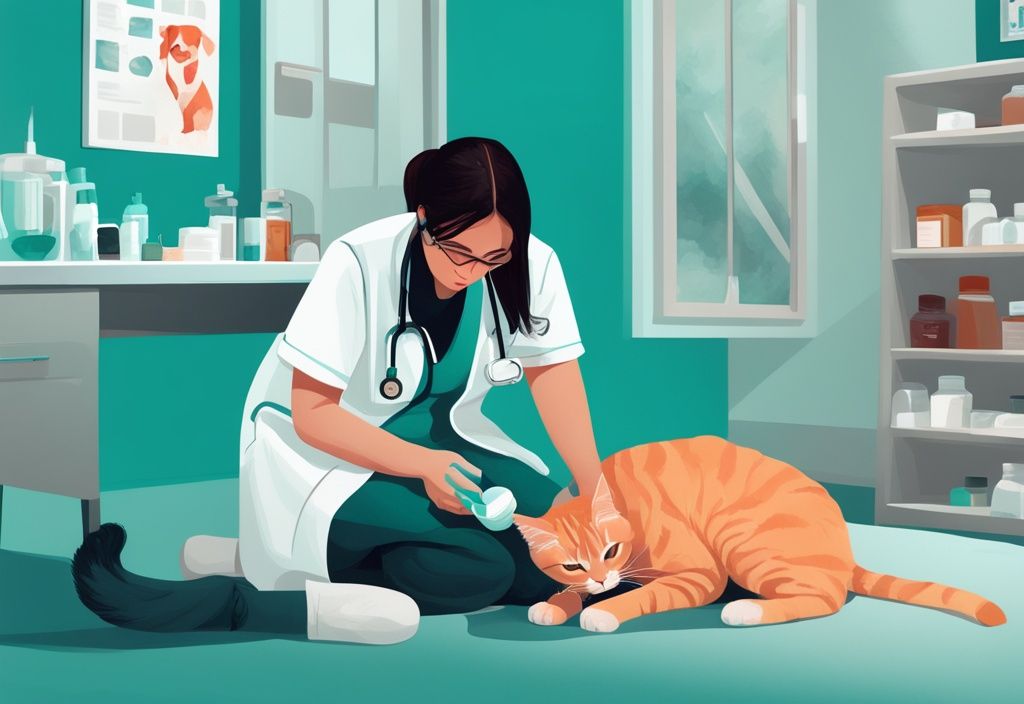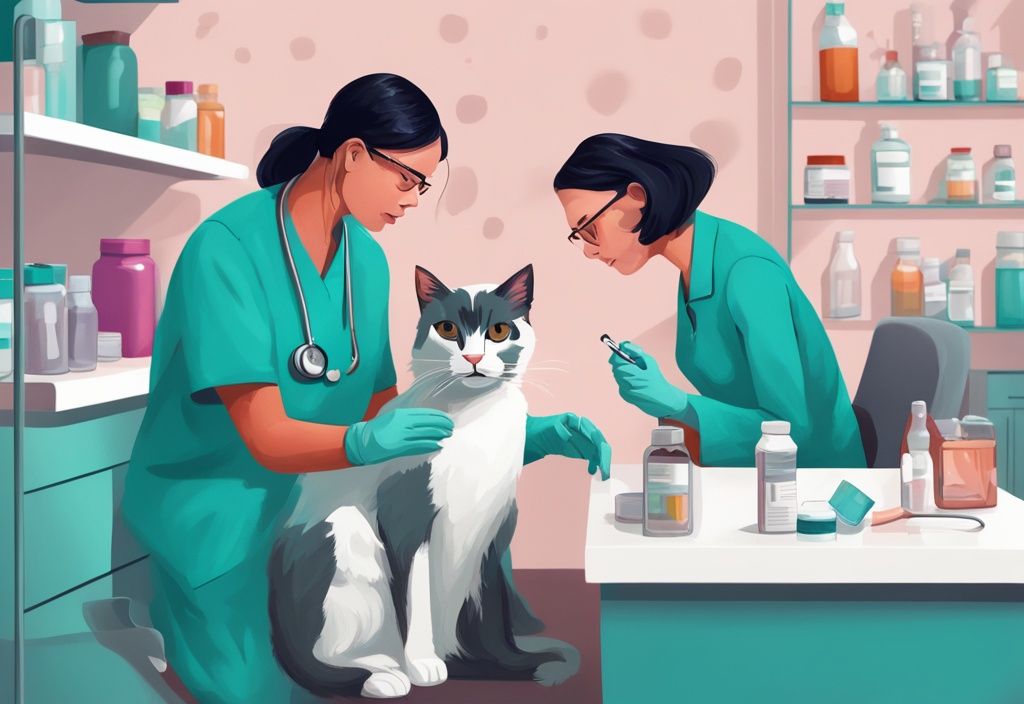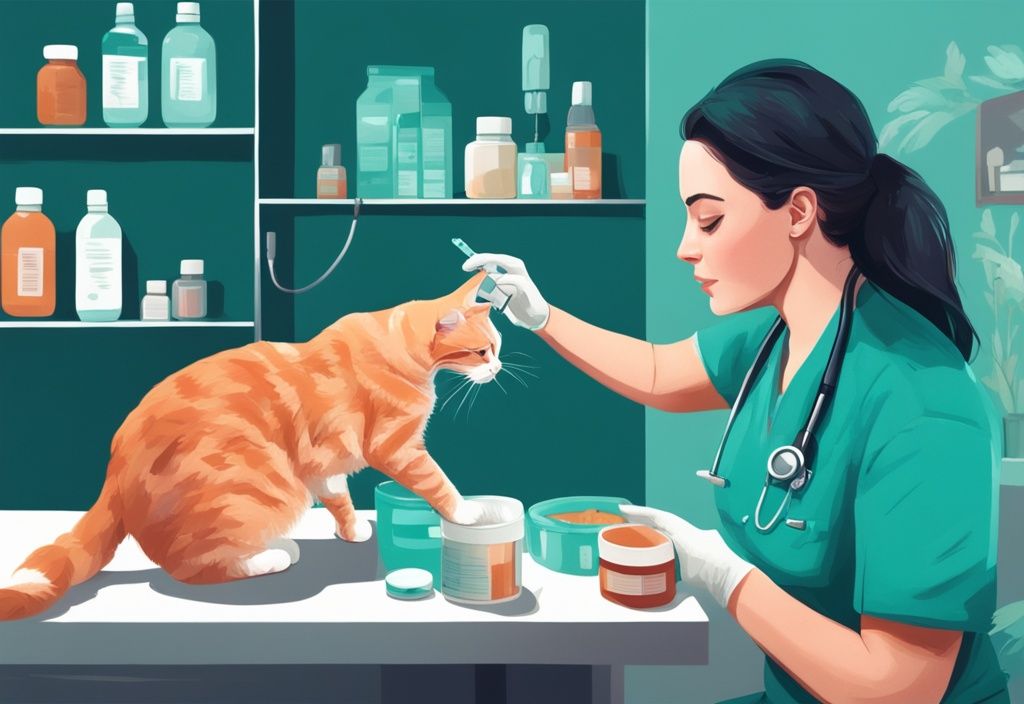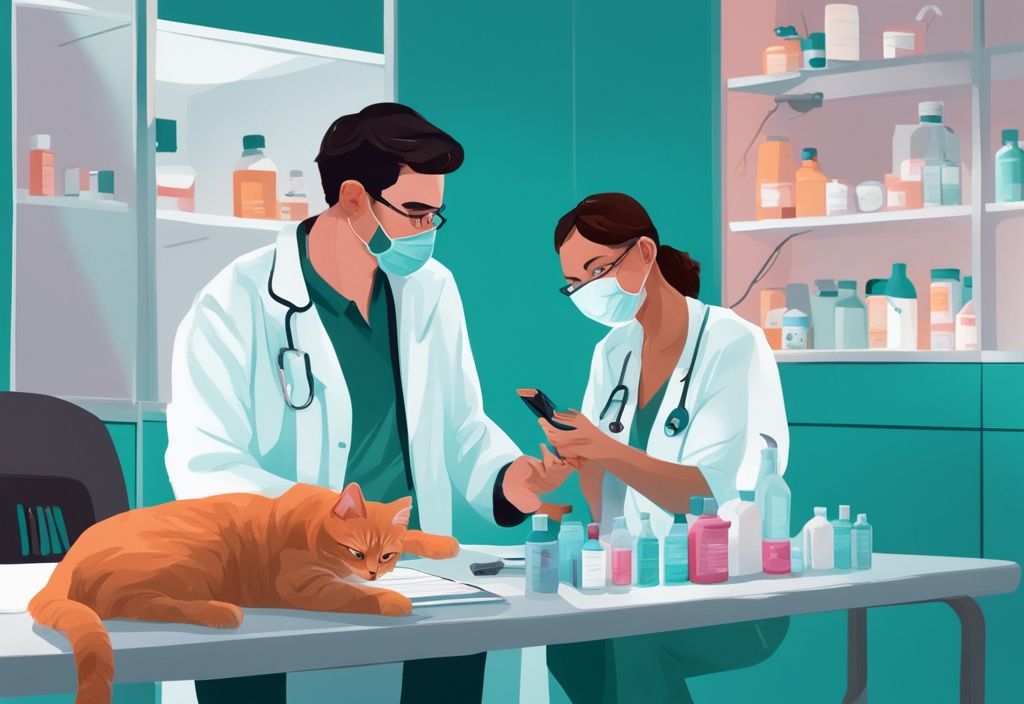Oh, the joys of being a pet parent! Just like my Whiskers, your cat might not always tell you when something’s up. UTIs can sneak up on our furry pals, causing them discomfort. But don’t worry—I’ve got your back! With some keen observation and a sprinkle of expert advice, you’ll be well-equipped to tackle this. Ready to dive into the world of feline care and make your kitty purr with relief? Let’s get started!
Understanding Cat UTIs
When it comes to our feline friends, urinary tract infections (UTIs) can be quite the sneaky culprits. These pesky infections occur when bacteria decide to throw a party in your cat’s bladder or urethra, causing all sorts of discomfort. Cats over 10 years old are particularly prone to these unwelcome guests, especially if they have underlying conditions like diabetes or hyperthyroidism. Catching these issues early is like spotting a mouse before it scurries away—essential for keeping your kitty happy and healthy.
What is a Cat UTI?
Picture this: your cat’s bladder is like a cozy hammock, but when bacteria crash the scene, it turns into a battleground. That’s a cat UTI for you! These infections often pop up in older cats, especially those with certain health conditions. Understanding the signs and causes, including conditions like lower urinary tract disease (LUTD), is like having a secret map to your cat’s health, guiding you to effective treatment. For more information, check out this resource on lower urinary tract disease.
Symptoms of a Cat UTI
Spotting the signs of a cat UTI can feel a bit like playing detective. Does your kitty seem to be visiting the litter box more frequently but only leaving behind tiny puddles? That’s a clue! Straining during urination or finding little “accidents” outside the box are other hints. And if you notice blood-tinged urine or your cat licking their urinary opening more than usual, it’s time to consider a trip to the vet. Being on the lookout for these symptoms is like having a sixth sense for your cat’s well-being, ensuring you can act quickly and keep your furry friend purring contentedly.
Immediate Steps to Take for Suspected Cat UTIs
When your feline friend starts acting a bit off, it’s time to spring into action! Suspecting a urinary tract infection (UTI) in your cat means it’s crucial to act quickly to ensure their health and happiness.
The Importance of Immediate Veterinary Consultation
First things first, reach out to your vet pronto! Cats are sneaky little creatures when it comes to hiding discomfort. Have you ever noticed how Whiskers, my cuddly rescue cat, can pretend everything’s fine even when he’s not? That’s why it’s important to watch for early signs like frequent urination, straining, or blood-tinged urine. These are your clues to get that vet appointment on the calendar.

Why the rush, you ask? Well, a prompt veterinary consultation means an early diagnosis, which can stop the infection from turning into a bigger, scarier problem. The vet will likely do some tests, like urinalysis or bloodwork, to figure out exactly what’s going on. This isn’t just about spotting a UTI; it’s about making sure there aren’t any other sneaky health issues lurking in the background.
Once the vet has a plan, it’s all about following their advice to a T. Completing the full course of any prescribed antibiotics is a must, even if your kitty starts to feel better. Think of it like finishing a mystery novel—don’t stop until you know how it ends! This ensures the infection is fully cleared and helps prevent it from making a comeback.
And don’t forget those follow-up visits! They’re like the encore at a concert—essential for confirming that the infection has been successfully treated. By sticking to the vet’s guidance, you can help your cat bounce back quickly and keep future UTIs at bay. Plus, you’ll be ensuring their overall well-being and comfort, which is what being a pet parent is all about, right?
Diagnosing Cat UTIs
When it comes to figuring out what’s going on with our feline friends, diagnosing a cat UTI is a bit like piecing together a mystery. Let’s dive into the steps that veterinarians take to solve this puzzle and get your kitty back to their playful self.
Veterinary Diagnostic Procedures
First up, a trip to the vet is in order! Imagine your cat, Whiskers, perched on the exam table, looking a bit like a royal inspecting their kingdom. The vet starts with a thorough physical examination, checking for any signs of discomfort. This is where the detective work begins. A urine sample is a must-have clue in this investigation. It helps spot any bacteria or sneaky abnormalities lurking in the shadows.
Sometimes, the plot thickens, and additional tests like X-rays or bloodwork are needed. These tests can reveal hidden culprits like bladder stones or other conditions that might be stirring up trouble. It’s all about getting to the root of the issue, ensuring Whiskers can go back to chasing butterflies in no time.
Common Tests for UTI Diagnosis
Now, let’s talk about the trusty tests veterinarians use. A urinalysis is the star of the show here. It checks for bacteria, blood, and crystals in the urine—those telltale signs of a UTI. If you’re a pet owner, particularly of a Bengal cat, understanding these signs can be crucial for your pet’s health. But wait, there’s more! Blood tests might also be on the docket to rule out underlying conditions like diabetes or hyperthyroidism, which can make cats more prone to UTIs.
In some cases, imaging tests such as ultrasounds or X-rays are brought in to provide a clearer picture of the urinary tract. Think of it as getting a bird’s-eye view of the situation. These comprehensive diagnostic procedures ensure that the root cause of the UTI is identified and treated effectively.
Treatment Options for Cat UTIs
When your feline friend is dealing with a urinary tract infection, it’s crucial to explore all the treatment avenues available. From veterinary interventions to natural remedies, there are several ways to help your cat get back to their playful self. Let’s dive into the options!

Veterinary Treatments
Antibiotics and Medication
Antibiotics are often the go-to solution for cat UTIs, acting like tiny warriors fighting off those pesky bacteria. It’s super important to let your cat finish the entire course of antibiotics, even if they seem to be back to their mischievous antics in no time. Why, you ask? Sometimes, cat owners might notice unusual behaviors, like twitching during sleep, which can be concerning. If you’re wondering, why is my cat twitching in his sleep, understanding these behaviors can help you care better for your feline friend. Well, stopping early can lead to the infection making a comeback and might even lead to antibiotic resistance. And don’t forget those follow-up vet visits—they’re like a safety net, ensuring the infection is truly gone and your kitty is on the mend.
How to Treat Cat UTI Naturally
At-Home Remedies
If you’re a fan of natural approaches, there are some nifty tricks to try at home. Cranberries, for instance, can help lower urine pH if it’s too alkaline. And apple cider vinegar? It’s like a little pH balancer in a bottle! Mix it with your cat’s food or broth to make it more appealing. Marshmallow root is another gem, acting as a diuretic and soothing the bladder lining, making those trips to the litter box a bit more comfortable.
Supplements and Natural Ingredients
Adding glucosamine and chondroitin to your cat’s diet can work wonders in rebuilding the bladder wall and cutting down inflammation. And let’s not forget the magic of water! Keeping your cat hydrated is key—think fresh water or a cat fountain to entice them to drink more. Bone broth is another hydration hero, packed with nutrients to bolster their immune system in the infection battle. Plus, it’s a tasty treat that Whiskers would give two paws up!
Preventing Cat UTIs
Keeping our feline friends healthy and happy involves a little bit of everything—from what they eat to how they play. Let’s dive into some purr-fect ways to prevent those pesky cat UTIs.
Diet and Nutrition
Ever heard the saying, “You are what you eat”? Well, it turns out our cats are no different! A proper diet is a game-changer in preventing cat UTIs. Vets often suggest tweaking your kitty’s diet to keep those urinary crystals at bay. Special diets can help maintain the right pH balance in their urine, making it harder for crystals to form. And here’s a little tip from my whiskered friend, Whiskers: wet food is a winner! Not only does it keep them hydrated, but it also encourages more frequent bathroom breaks, helping flush out any sneaky bacteria.
Maintaining a Clean Environment
Imagine walking into a messy bathroom—yikes, right? Cats feel the same about their litter boxes. Keeping it clean is crucial to prevent UTIs. Regularly changing the litter and giving the box a good scrub can keep bacteria at bay. Plus, a tidy litter box means a less stressed kitty, which is always a win. A clean space is like a spa day for your cat, encouraging them to do their business regularly and comfortably.
Reducing Stress in Cats
Stress can be a real troublemaker, even for our furry pals. Creating a stress-free environment can work wonders in preventing UTIs. Think of it as setting up a little paradise for your cat. Toys, activities, and a cozy spot to chill can make all the difference. Routine is key too—regular feeding, playtime, and naps can help your cat feel safe and secure. A content kitty is a healthy kitty, and that means fewer UTIs to worry about.
Complications and When to Seek Immediate Help
When it comes to our feline friends, urinary tract infections (UTIs) can be a sneaky little gremlin. They might start small, but if left unchecked, they can turn into a full-blown monster. Let’s dive into what can happen if a cat’s UTI isn’t treated and when it’s time to hit the panic button and call your vet.
Potential Complications from Untreated UTIs
Imagine a tiny traffic jam in your cat’s urethra—sounds uncomfortable, right? Well, that’s exactly what can happen if a UTI is left untreated. The urethra can become completely blocked, making it impossible for your cat to pee. This isn’t just a bad day; it’s a serious emergency. Toxins can build up, causing distress and potentially damaging organs. And that’s not all—untreated UTIs can lead to kidney failure. Picture a filter that stops working, and you get the idea. In the worst-case scenario, the bladder could even burst from all the pressure, which is as scary as it sounds. So, let’s nip this in the bud and keep those kitty kidneys happy!

Recognizing Emergency Situations
Now, how do you know when your cat’s UTI has gone from “Uh-oh” to “Oh no!”? Watch for signs like severe pain, difficulty urinating, or lethargy. If your cat is acting like it’s auditioning for a drama about a blocked urethra, it’s time to call the vet pronto. And if you see frequent urination or blood-tinged pee, don’t wait around. Catching these signs early can make all the difference. Remember, early detection is the name of the game when it comes to keeping your furry friend purring happily.
Conclusion
Spotting a cat UTI early is like finding a hidden treasure map—it leads to a swift recovery! Recognizing those pesky symptoms and acting quickly can stop the infection from turning into a bigger adventure than you’d like. If you suspect a UTI, it’s time to call in the experts. A vet will whip up a treatment plan that’s just right for your feline friend, often involving antibiotics and other meds. Following this plan is like following a recipe for success!
Keep your eyes peeled during and after treatment. Any recurring symptoms or quirky behavior might hint at a lingering issue. Regular check-ins with your vet are like pit stops on your cat’s journey back to health, ensuring everything’s on track.
Prevention is the name of the game when it comes to future UTIs. Think of it as building a fortress around your cat’s urinary health. A balanced diet, a clean environment, and a stress-free lifestyle are your trusty allies. By weaving these practices into your daily routine, you’re not just protecting your cat’s health—you’re enhancing their overall well-being. Remember, a proactive approach can make all the difference, keeping those UTIs and other health hiccups at bay!
Frequently Asked Questions
When it comes to our feline friends, understanding how to treat cat UTI is crucial. Here are some common questions pet owners have, answered with a touch of warmth and a sprinkle of humor.
Can a cat UTI go away on its own?
Oh, how I wish our cats could magically heal themselves! But alas, UTIs in cats usually need a vet’s touch. Ignoring a UTI is like letting a small leak turn into a flood—it can lead to serious issues like kidney damage or a blocked urethra, which is as scary as it sounds!
What are the best natural remedies for cat UTIs?
Looking for a natural twist? Cranberries and apple cider vinegar can help lower urine pH. I’ve found that supplements like glucosamine and chondroitin are like a spa day for Whiskers’ bladder. And don’t forget the power of hydration—bone broth is a hit in our house!
How can I prevent my cat from getting UTIs?
Prevention is the name of the game. A balanced diet and a clean environment are your best allies. Reducing stress is key—think of it as giving your cat a little zen retreat. And always keep an eye out for any sneaky underlying health issues.
How long does it take for a cat to recover from a UTI?
Recovery can be a bit of a journey, but sticking to the vet’s plan is like following a trusty map. Regular check-ups are essential to ensure the infection is gone for good. Plus, it helps prevent any unwanted encore performances!
